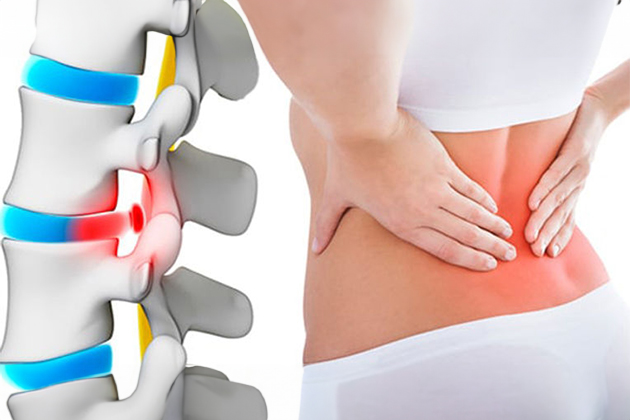
Structure and Function of the Spine
Our spine consists of interconnected bony structures called vertebrae. Our lower back comprises five vertebrae and the intervertebral discs, which act as cushions between them. The spine transfers the load from our torso to the hips and legs, providing our posture. It supports our body, allowing us to stand upright and bend in all directions. Vertebrae are connected by disc cushions and joints known as facet joints. Additionally, supporting ligaments and muscle tissue around the vertebrae ensure they remain firmly attached. These structures enable the spine to bear the body’s weight and allow for specific movements while maintaining an upright position.
Structure of Discs and Herniated Discs
Discs are sturdy connective tissues that connect vertebrae and function like cushions. They consist of a tough outer layer called the annulus fibrosus and a gel-like center called the nucleus pulposus. As we age, the nucleus pulposus loses its water content, diminishing its cushioning function. This condition can lead to a herniated disc when the disc center shifts through a tear in the outer layer. Herniated discs typically occur in the lower back’s last two discs. A herniated disc can cause back pain and press on nerves emanating from the spine, leading to sciatica, which manifests as pain, numbness, and weakness in the legs.
Treatment Options for Herniated Discs
Short-term Rest and Medications:
- Pain relievers to control pain
- Physical therapy
- Exercises
- Epidural injections
Avoiding Long-term Rest:
- Prolonged bed rest can cause joint stiffness and muscle weakness, making it harder to perform pain-relieving movements.
- Light stretching exercises and posture changes are recommended.
Physical Examination and Diagnosis:
- Straight leg raise test indicating sciatica pain
- Muscle weakness, numbness, and reflex changes
- Imaging methods like MRI and CT scans can definitively show nerve compression.
Microdiscectomy
- Common methods:
- Microdiscectomy using a microscope (micro surgery)
- Endoscopic discectomy using an endoscope
Surgery Process:
- Performed under spinal or general anesthesia.
- The patient lies face down on the operating table.
- A small incision is made on the skin over the herniated disc space, and muscles are stripped from the bone.
- A small piece of bone may be removed to see the compressed nerve.
- The herniated disc and broken pieces are removed to relieve nerve compression.
Post-Surgery:
- An incision smaller than 2 cm is made.
- The patient is mobilized 6 hours after surgery and discharged after one night in the hospital.
Post-Surgery Precautions
- Avoid driving for the first four weeks.
- Avoid prolonged sitting, lifting heavy loads, and bending forward.
- Move your body parts in alignment with your hips and shoulders.
- Increase activity levels gradually with slow movements.
- Avoid lifting heavy objects.
- Participate in a physical therapy or rehabilitation program.
- Pay attention to sleep and rest patterns.
- Ensure a balanced diet.
- Avoid smoking and alcohol.
- Avoid stress and practice meditation or deep breathing exercises.
- Continue regular doctor check-ups.
Non-Surgical Treatments
Radiofrequency Thermocoagulation:
- Damaged nerve tissue is destroyed using radiofrequency energy.
Transforaminal Injection:
- Steroids or anesthetic agents are injected into nerve roots.
Facet Joint Injection:
- Steroids or anesthetic agents are injected to relieve pain in the facet joints.
Ozone Therapy:
- Ozone gas is used to oxygenate damaged tissue and reduce inflammation.
These treatment methods aim to alleviate herniated disc symptoms and improve patients’ quality of life. Your neurosurgeon will evaluate the patient’s condition to determine the most suitable treatment method.
Frequently Asked Questions
A herniated disc is diagnosed based on the patient’s complaints and physical examination findings. Imaging methods such as MRI (Magnetic Resonance Imaging), CT (Computed Tomography), and X-ray can be used to confirm the diagnosis. Additionally, an EMG (Electromyography) test can be used to determine the extent of nerve damage.
Symptoms of a herniated disc include lower back pain, pain radiating from the hip to the leg (sciatica), numbness or tingling in the legs, weakness in the legs, restricted movement, and rarely, loss of bladder or bowel control. Pain may worsen with coughing, sneezing, or prolonged sitting.
Boyun fıtığının temel patolojisi, servikal omurga disklerinin sıkışması veya yırtılması sonucu ortaya çıkar. Bu durum, disklerin normal işlevlerini yerine getirememesine ve çevreleyen sinir dokularına baskı yapmasına yol açar. Disklerin iç kısmında yer alan jelin sızması, enflamasyona ve sinir tahribatına neden olabilir. Bu nedenle, boyun fıtığı hastalığının mekanizması hem mekanik hem de inflamatuar bileşenleri içerir.
Surgical treatment is preferred in the following cases:
If the pain does not subside with medical treatment
If the severity of the pain is increasing
If you cannot perform daily activities
If there are serious issues like significant weakness and incontinence
Surgical treatment is generally recommended to relieve leg pain and prevent progressive weakness. This treatment has a success rate of over 90%.
The recovery process after herniated disc surgery varies depending on the type of surgical intervention performed and the patient’s overall health condition. Post-surgery, physical therapy and rehabilitation are important to speed up the recovery process and maintain spinal health. Post-surgery care includes adhering to the prescribed exercise program, taking prescribed medications for pain management, and avoiding heavy lifting or strenuous activities. Regular follow-ups and adherence to the doctor’s instructions are also crucial during the recovery process.

